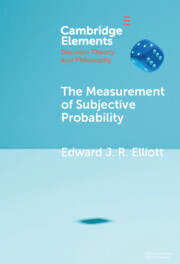373 results
Non-agreeing degree constructions
-
- Journal:
- Journal of Linguistics , First View
- Published online by Cambridge University Press:
- 04 June 2024, pp. 1-36
-
- Article
-
- You have access
- Open access
- HTML
- Export citation
Introducing ICBe: an event extraction dataset from narratives about international crises
-
- Journal:
- Political Science Research and Methods , First View
- Published online by Cambridge University Press:
- 24 May 2024, pp. 1-21
-
- Article
-
- You have access
- Open access
- HTML
- Export citation
Flexible Estimation of Policy Preferences for Witnesses in Committee Hearings
-
- Journal:
- Political Analysis , First View
- Published online by Cambridge University Press:
- 09 May 2024, pp. 1-17
-
- Article
-
- You have access
- Open access
- HTML
- Export citation
Revisiting the evidence on thermostatic response to democratic change: degrees of democratic support or researcher degrees of freedom?
-
- Journal:
- Political Science Research and Methods , First View
- Published online by Cambridge University Press:
- 02 May 2024, pp. 1-7
-
- Article
-
- You have access
- Open access
- HTML
- Export citation
9 - Managing Begins with Measuring
- from Part III - Measuring Toxic Stress
-
- Book:
- Toxic Stress
- Published online:
- 18 April 2024
- Print publication:
- 18 April 2024, pp 179-195
-
- Chapter
- Export citation
1 - Toxic Stress – You Won’t See It Coming (Neither Will Your Doctor)
- from Part I - The Problem
-
- Book:
- Toxic Stress
- Published online:
- 18 April 2024
- Print publication:
- 18 April 2024, pp 19-37
-
- Chapter
- Export citation

The Measurement of Subjective Probability
-
- Published online:
- 13 April 2024
- Print publication:
- 02 May 2024
-
- Element
- Export citation
16 - The Displacement of Ethics in Education through Educational Standardization
- from Part II - Ethics and Education in Practice
-
-
- Book:
- The Cambridge Handbook of Ethics and Education
- Published online:
- 07 March 2024
- Print publication:
- 14 March 2024, pp 330-351
-
- Chapter
- Export citation
Self-reported political ideology
-
- Journal:
- Political Science Research and Methods , First View
- Published online by Cambridge University Press:
- 22 February 2024, pp. 1-22
-
- Article
-
- You have access
- Open access
- HTML
- Export citation
Chapter 7 - Virtues as Scalar Traits
- from Part III - Organizing Virtue Research with the STRIVE-4 Model
-
- Book:
- The Science of Virtue
- Published online:
- 11 January 2024
- Print publication:
- 01 February 2024, pp 177-201
-
- Chapter
- Export citation
5 - The Measurement of Positive Partisan Identity
-
- Book:
- When Politics Becomes Personal
- Published online:
- 04 January 2024
- Print publication:
- 18 January 2024, pp 46-60
-
- Chapter
- Export citation
6 - The Measurement of Negative Partisan Identity
-
- Book:
- When Politics Becomes Personal
- Published online:
- 04 January 2024
- Print publication:
- 18 January 2024, pp 61-75
-
- Chapter
- Export citation
3 - Kuhn’s “Fifth Law of Thermodynamics”
- from Part II - Normal Science and Science Education
-
-
- Book:
- Kuhn's <i>The Structure of Scientific Revolutions</i> at 60
- Published online:
- 05 January 2024
- Print publication:
- 18 January 2024, pp 55-78
-
- Chapter
- Export citation
Establishing the validity and robustness of facial electromyography measures for political science
-
- Journal:
- Politics and the Life Sciences , First View
- Published online by Cambridge University Press:
- 15 January 2024, pp. 1-18
-
- Article
-
- You have access
- Open access
- HTML
- Export citation
Quality in Measurement Matters: Adjusted American Bar Association Ratings and Circuit Court Confirmation Hearing Word Choice
-
- Journal:
- Journal of Law and Courts ,
- Published online by Cambridge University Press:
- 10 January 2024, pp. 1-22
-
- Article
- Export citation
Are remote health clinics primary health care focused? Validation of the Primary Health Care Engagement (PHCE) Scale for the Australian remote primary health care setting
-
- Journal:
- Primary Health Care Research & Development / Volume 25 / 2024
- Published online by Cambridge University Press:
- 05 January 2024, e3
-
- Article
-
- You have access
- Open access
- HTML
- Export citation
4 - Measuring Political Inequality
- from Part I - Government Responsiveness
-
-
- Book:
- Unequal Democracies
- Published online:
- 07 December 2023
- Print publication:
- 21 December 2023, pp 77-97
-
- Chapter
-
- You have access
- Open access
- HTML
- Export citation
Chapter 3 - Information Privacy
- from Part I - Foundations
-
-
- Book:
- Technology and Measurement around the Globe
- Published online:
- 08 November 2023
- Print publication:
- 09 November 2023, pp 107-128
-
- Chapter
- Export citation
Chapter 10 - Testing and Measurement in North America with a Focus on Transformation
- from Part III - Regional Focus
-
-
- Book:
- Technology and Measurement around the Globe
- Published online:
- 08 November 2023
- Print publication:
- 09 November 2023, pp 308-325
-
- Chapter
- Export citation
Chapter 11 - Technology and Measurement Challenges in Education and the Labor Market in South America
- from Part III - Regional Focus
-
-
- Book:
- Technology and Measurement around the Globe
- Published online:
- 08 November 2023
- Print publication:
- 09 November 2023, pp 326-348
-
- Chapter
- Export citation



